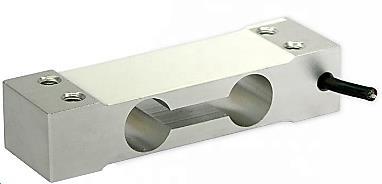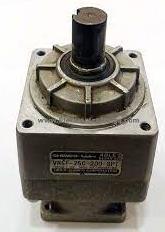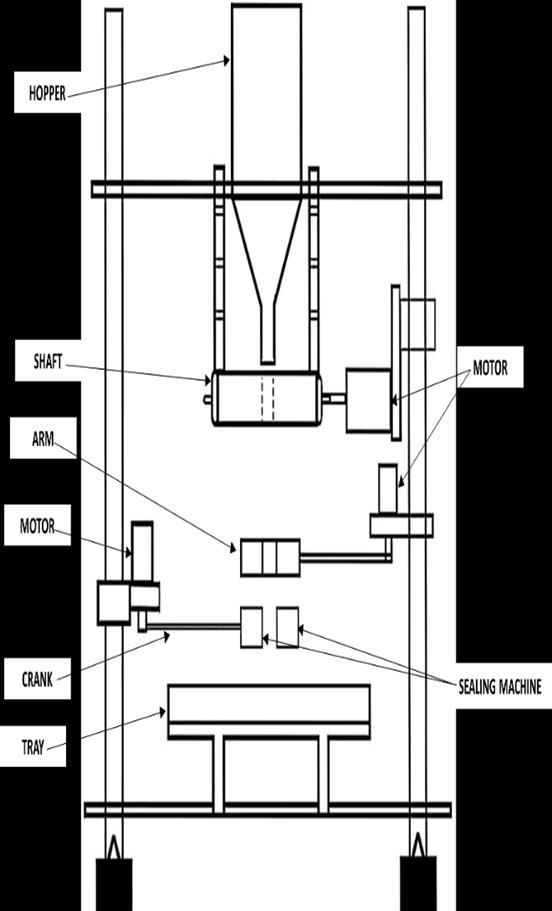
International Research Journal of Engineering and Technology (IRJET) e-ISSN: 2395-0056
Volume: 11 Issue: 03 | Mar 2024 www.irjet.net p-ISSN: 2395-0072
AUTOMATIC FILLING AND SEALING MACHINE
Harsh Nilesh Narvekar1, Siddharth Gajanan Chavan2, Sahil Santosh Panchal3 , Rushikesh Milind Mestry4, Mrs. Shamal Bagal5, Mrs. Nehal Muchhala6
1Student, Diploma in Mechanical Engineering, Thakur Polytechnic, Kandivali, Maharashtra, India
2 Student, Diploma in Mechanical Engineering, Thakur Polytechnic, Kandivali, Maharashtra, India
3 Student, Diploma in Mechanical Engineering, Thakur Polytechnic, Kandivali, Maharashtra, India
4 Student, Diploma in Mechanical Engineering, Thakur Polytechnic, Kandivali, Maharashtra, India
5 Lecturer, Diploma in Mechanical Engineering, Thakur Polytechnic, Kandivali, Maharashtra, India
6 Head of Department of Mechanical Engineering, Diploma in Mechanical Engineering, Thakur Polytechnic, Kandivali, Maharashtra, India
Abstract- This paper presents the design and implementation of an automatic filling and sealing machine tailored for grocery stores to enhance operational efficiency and reduce packaging time. The machine aims to streamline thepackagingprocess, ensuringconsistencyinpackagingsize, weight, and sealing while preserving product freshness. By automatingthesetasks, themachine minimizesmanuallabor, thus increasing production output and meeting customer demand effectively. The design incorporates customization options for packaging sizes, shapes, and materials to adapt to various product requirements and consumer preferences. Through this innovation, grocery stores can improve overall efficiency, reduce costs, and maintain high standards of product quality, ultimately enhancing customer satisfaction and loyalty.
Key Words: Automatic Filling and Sealing Machine, Grocery Stores, Operational efficiency, Automation, Enhancing customer satisfaction.
1.INTRODUCTION
Grocerystoresarepivotalincateringtothedailyneedsof consumers,necessitating efficient andtimely processes to meet the ever-growing demand for packaged goods. However,traditionalmanualmethodsoffillingandsealing products often fall short in terms of time efficiency and operationaleffectiveness.Inthiscontext,theintegrationof automatic filling and sealing machine emerges as a promising solution to address the challenges faced by grocery stores. This machine is designed to streamline packagingprocesses,ensuringconsistency,andqualitywhile significantly reducing time and labor costs. This paper explores the design and implementation of an automatic fillingandsealingmachinetailoredspecificallyforgrocery stores, aimed at increasing efficiency and reducing time constraints. By leveraging automation technology, this machine has the potential to revolutionize packaging operations in grocery stores, enabling them to meet
customerdemandseffectivelyandmaintaincompetitiveness intheretailindustry.
1.1 Problem Statement
Theproblemstatementforautomaticfillingandsealing machineingrocerystoresistooptimizepackagingprocesses tomeetconsumerdemandwhileensuringproductquality, freshness, and regulatory compliance. Challenges include efficientoperation,errorreduction,laborcostminimization, andadaptingtodiverseproductrequirementsandpackaging preferences. Additionally, concerns arise about perishable goods preservation, hygiene standards, and the need for continuousinnovationtomeetevolvingmarketdemands.
1.2 Objective
Automatic filling and sealing machine in grocery stores optimize packaging processes, ensuring consistency, freshness,andregulatorycompliancewhilereducingmanual labor and costs. This enhances operational efficiency, minimizes errors, and boosts brand image, ultimately enhancingcustomersatisfaction.
2. RESOURCES NEEDED
Themaincomponentsofthissystemaregivenbelow:
PLC
LOADCELL HMI(HumanMachineInterface) SERVOMOTORS SENSORS
(a)PLC:
A PLC, or Programmable Logic Controller, is a ruggedized industrial computer used to automate electromechanical processes by monitoring inputs, executing logic based on

Volume: 11 Issue: 03 | Mar 2024 www.irjet.net p-ISSN: 2395-0072
programmed instructions, and controlling outputs accordingly.
Need of Delta DVP 28SV PLC:
TheDVP28SVPLCwasselectedduetoitscompatibilityand tailored functionality for seamlessly integrating with load cellsinourautomationsetup.Itsspecializedinputmodules oranaloginputchannelsaredesignedtoefficientlyinterface with load cells, offering high-resolution analog-to-digital conversionforprecisesignalacquisition.Additionally,these modules incorporate advanced features like filtering and calibration to enhance the accuracy and reliability of load cellsignalmeasurement.Byleveragingthesecapabilities,the PLCfacilitatesseamlessintegrationofloadcellfunctionality into our automation system, ensuring accurate and dependableperformanceinmonitoringandcontrollingloadrelatedprocesses.

(b)Load Cell and Its Module:
Load cells are crucial transducers converting force into electricalsignalsforprecisemeasurementsinindustrialand scientificfields.Withtheirreliableconversionmechanism, loadcellsaidinessentialdataacquisitionforqualitycontrol andresearchpurposes.
Need of DVP201LC-SL Load Cell Module:
The DVP 201LC SL load cell module was chosen for its compatibility with the DVP 28SV PLC and its specialized capabilitytointerfacewithloadcells.Featuringdedicated analog input channels, it ensures accurate signal conditioning and processing of load cell outputs, enabling precise measurement of force or weight. Integrated seamlessly into the PLC programming environment, it enables precise control and monitoring of load-related processeswithinourautomationsystem.


(c)HMI (Human Machine Interface):
HMI, or Human-Machine Interface, facilitates user interaction with machines via touchscreens or graphical displays, enabling control and monitoring of automated systems.
Need of HMI:
TheintegrationofasingleHuman-MachineInterface(HMI) deviceinsteadofseparatedisplayandkeypadcomponents streamlines user interaction and reduces hardware complexity. This consolidated approach optimizes space utilizationandsimplifieswiring,resultinginamoreefficient and cost-effective control system design. Additionally, the unifiedHMIprovidesa cohesiveuserinterface, enhancing user experience and facilitating intuitive operation within ourautomationsetup

(d)Servo Motor:
A servo motor functions as a rotary actuator, enabling precise management of angular position, velocity, and acceleration. It comprises a motor linked with a feedback

International Research Journal of Engineering and Technology (IRJET) e-ISSN: 2395-0056
Volume: 11 Issue: 03 | Mar 2024 www.irjet.net p-ISSN: 2395-0072
sensor,ensuringmeticulous andcontrolledmotion within automationsetups.
Need of Servo Motor:
TheselectionofthePanasonic200W3000rpmservomotor wasdrivenbytherequirementforpreciseshaftrotationin ourapplication.IntegratedwithaPLC,itfacilitatesaccurate controloverthemotor'sangularposition,enablingprecise positioning and stopping at specific angles. With its rated power and rotational speed, the Panasonic servo motor offersthenecessarytorqueandvelocitycapabilitiestomeet ourrotationaldegreespecifications Thisservomotor'shighspeed operation and accurate feedback system ensure reliableperformance,meetingthestringentdemandsofour automationsystemforprecisemotioncontrol.


TheselectionofthePanasonic400W3000rpmservomotor withgearboxwasnecessitatedbythespecificrequirements ofourapplication,whichinvolvedtheoperationofanarm andacrankmechanism.Theadditionofthegearboxserves toreducetherotationalspeedofthemotorwhileincreasing torqueoutput,enablingefficientoperationofthearmand crank system. Without the gearbox, the motor would be subjectedtohunting,causinginstabilityandinefficiencyin motion control. Additionally, the choice of a 400W motor over a 200W motor was driven by the need for increased powertoeffectivelydrivetheloadandensuresmoothand precise movement of the mechanism. This configuration optimizes performance and reliability, meeting the demandingrequirementsofourapplication.



(e)Sensors:
Asensorfunctionsasatooltoidentifyorquantifyphysical attributes and transform them into interpretable signals, either for an observer or a computer. These devices find widespread use in diverse applications, including monitoring, control systems, and electronic devices, facilitatingthecollectionof pertinent data regarding their surroundings.
Need of Sensors:
The utilization of the Inductive Sensor NBB8-18GM50-E2 and GTB6 N1212 sensors in our system serves specific purposes.TheGTB6N1212sensorisemployedfordetecting thepresenceofaplasticbag.Itsadvancedtechnologyallows reliableidentificationofnon-metallicmaterialslikeplastic. Ontheotherhand,theNBB8-18GM50-E2inductivesensoris utilizedformetaldetection,assistinginaccuratelystopping theservomotorsatpredefinedangles.Whenametalobject isdetected,thesensortriggersthecontrolsystemtohaltthe servomotors,ensuringprecisepositioning.Thisdual-sensor approachenhancestheautomationsystem'saccuracyand reliability in handling plastic bagswhileachieving precise servomotorcontrolbasedonmetaldetection.

International Research Journal of Engineering and Technology (IRJET) e-ISSN: 2395-0056
Volume: 11 Issue: 03 | Mar 2024 www.irjet.net p-ISSN: 2395-0072
NBB8-18GM50-E2 SENSOR GTB6 N1212 SENSOR



3. BLOCK DIAGRAM

Fig -12: BlockDiagram
Working:
The block represents a control system that uses a Programmable Logic Controller (PLC) to manage various motors and inputs in an industrial setting. Here's a breakdownofthecomponentsandhowtheyworktogether:
1) PLC (Programmable Logic Controller): This is the centralunitthatcontrolstheentiresystem.Itreceives input signals from various sensors and devices, processes these signals according to the programmed logic, and then sends output signals to control the motors.
2) HMI (Human-Machine Interface): This is the user interface that allows an operator to interact with the PLC. The operator can monitor system status, input commands,andmakeadjustmentstothePLCprogramif necessary.

International Research Journal of Engineering and Technology (IRJET) e-ISSN: 2395-0056
Volume: 11 Issue: 03 | Mar 2024 www.irjet.net p-ISSN: 2395-0072
3) Load Cell: This is a type of sensor that measures the weight.ThesignalfromtheloadcellissenttothePLC, whichcanusethisinformationtomakedecisions,such ascontrollingthemotorforclosingthenozzle.
4) Motor Drivers: These devices act as intermediaries betweenthePLCandthemotors.Theyreceivecontrol signalsfromthePLCandsupplythenecessarypowerto themotorstodrivethemasinstructed.
5) Motors (MOTOR 1, MOTOR 2, MOTOR 3): Theseare the actuators in the system that perform physical actions,suchasmovinganarm,adjustinganozzleand sealing a package. Each motor is controlled by its respectivemotordriver.
6) Inputs to the PLC: The diagram lists several inputs which are connected to the PLC. These inputs are sensorsthatprovidethePLCwithinformationaboutthe system'sstate.Forexample:
a. X3,X4,andX5aresensorsindicatingwhethereach motorisinitshomeposition.
b. X6isanemergencystopbuttonthat,whenpressed, sendsasignaltothePLCtohaltalloperationsfor safetyreasons
c. X7isasensorthatdetectsthepresenceofaplastic bag,forapackagingprocess.
7) Outputs from the PLC: The outputs are the control signals sent from the PLC to the motor drivers, instructingthemotorstomovetospecificpositionsor performcertainactions.
In operation, the PLC continuously monitors the input signals,processesthemaccordingtoitsprogrammedlogic, andsendsoutcommandstothemotordrivers.Themotor drivers then power the motors to perform tasks such as movingtoaforwardposition(asindicatedbyX10,X11and X12formotors1,2and3respectively).
The HMI provides a user interface for monitoring and control, allowing an operator to oversee the process and make adjustments as needed. The load cell input is an exampleofa feedback mechanismthatthePLCcanuseto ensureprecisecontroloverthesystem,suchasmaintaining aspecificweightduringoperation.
4. RESULT
The rapid filling and sealing capabilities of the automatic filling and sealing machine demonstrate its high-speed performanceinpackagingoperations.Withtheabilitytofill and seal a 500-gram pouch within just 10 seconds, the machineshowcasesexceptionalefficiencyandproductivity. Thisimpressivespeedisachievedthroughtheintegrationof advanced mechanical and electrical components, precise
controlalgorithmsimplementedinthePLC,andoptimized processparameters.Thefillingmechanismensuresaccurate dosingoftheproduct,whilethesealingunitswiftlysealsthe pouch with precision. Additionally, the seamless coordination of various subsystems within the machine enablesrapidcycletimes,allowingforquickturnaroundand increased throughput in production. Overall, the fastprocessing speed of the automatic filling and sealing machineunderscoresitscapabilitytomeetthedemanding requirements of high-volume packaging operations in variousindustries.
5. CONCLUSIONS
In conclusion, the development and implementation of automatic filling and sealing machine for grocery stores represent a significant advancement in packaging technology,addressingkeychallengesinmeetingconsumer demand while ensuring product quality, freshness, and regulatory compliance. Through this project, we gained valuableexperienceandknowledgeinseveralareas.Firstly, wedeepenedourunderstandingofautomationsystemsand their applications in the retail industry, particularly in optimizing packaging processes for perishable goods. Secondly, we enhanced our technical expertise in PLC programming, load cell interfacing, and HMI integration, crucial components in the design and operation of the machine. Overall, this project provided us with invaluable hands-on experience and knowledge in developing innovativesolutionstoaddressreal-worldchallengesinthe grocerystoreindustry.
REFERENCES
[1] Prof. S. B. Mandlik, along with Patole Abhishek, Alase Aishwarya, and Modhe Anuja, made significant contributions to a special issue featured in the International Journal of Current Engineering and Technology(E-ISSN2277–4106,P-ISSN2347–5161) inMarch2016.
[2] The same special issue of the International Journal of Current Engineering and Technology (E-ISSN 2277 –4106, P-ISSN 2347 – 5161) in March 2016 also showcasedtheworkofM.R.Saraf,V.V.Ruiwale,V.V. Kulkarni,andS.M.Kulkarni.
[3] AlbertoRegattieria,FrancescoPianaa,MauroGamberia, Francesco Gabriele Galiziab, and Andrea Castoa presentedtheirresearchonthe"Reliabilityassessment of a packaging automatic machine by accelerated life testingapproach"atthe27thInternationalConference on Flexible Automation and Intelligent Manufacturing (FAIM2017), held from June 27-30, 2017, in Modena, Italy.ThepaperwassubsequentlypublishedbyElsevier undertheISSN2351-9789.

International Research Journal of Engineering and Technology (IRJET) e-ISSN: 2395-0056
Volume: 11 Issue: 03 | Mar 2024 www.irjet.net p-ISSN: 2395-0072
[4] DirkSchaeferandWaiM.Cheungdelvedintothesubject of"SmartPackaging:OpportunitiesandChallenges"at the 51st CIRP Conference on Manufacturing Systems. ThisexplorationwaspublishedinProcediaCIRP72in 2018byElsevierB.V.
[5] AgnesL.Karmausa,RonOsbornb,andMansiKrishanc orchestratedaworkshoptitled"Scientificadvancesand challenges in safety evaluation of food packaging materials." The proceedings of this workshop were publishedbyElsevierInc.underanopenaccesslicense (CCBY-NC-ND).
2024, IRJET | Impact Factor value: 8.226 |
